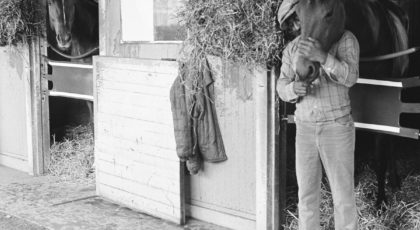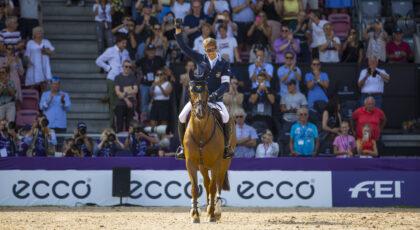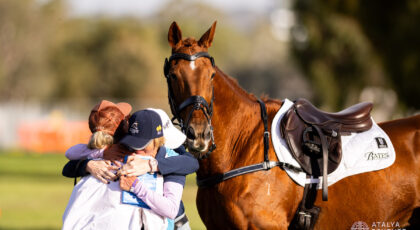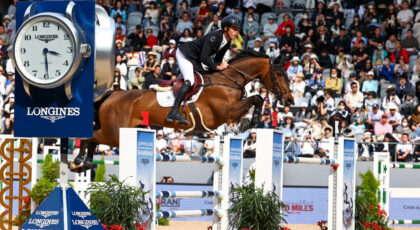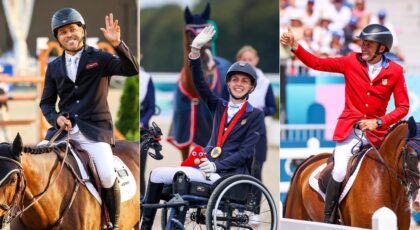The kind and natural approach
Several years ago, in search of an ethical alternative to the harsh and seemingly senseless mainstream training techniques, I began following a system of natural horsemanship. Much like the rest, the system used pressure and release—going to comfort and exercises such as desensitization. It supposedly taught the horse to respect you as the dominant leader based on the natural interactions of horses within a herd. We were assured that it was kind, in the horse’s best interest and of course, natural.

© Beth Gibbons
Unfortunately, what often gets sold to the well-meaning horse lover is not always as gentle as it’s made out to be. Whether deliberately or not, the horseman will explain certain behavioral phenomenon using seemingly fabricated theories which fit the lessons he is trying to teach. The result is that horse lovers who think they are doing the best thing by their animals actually end up putting them through things they might never have considered before. It is not just the horse who suffers, a great deal of emotional stress is also often experienced by the trainer.
Eventually I became disillusioned with the natural horsemanship system as I came to recognize these attributes, and so left in search of a more ethical alternative. In this article I want to explain some of the basic scientific mechanisms behind the “magic”, and help you recognize when the explanation might not fit the situation. Once you understand the basic principles, you are in a better position to make informed decisions about what is actually best for you and your horse.
Deliberately pushing the boundaries
In order to maintain the façade that the system is as kind as it states to be, clever language and humor are often used to persuade the viewer. Passive and jovial comments remove the negative stigma from certain situations or stimuli, such as naming a whip a “carrot stick” or “extended arm”. To complicate things further the whole process is viewed within an anthropomorphic and anthropocentric framework, meaning that human traits are used to explain equine behavior and the trainer is seen as being central to the behavior displayed. This causes damaging misinterpretation of responses which are likely to be simply fight-or-flight in nature based on the horses’ natural instincts.
Instead, it is often assumed that the horse does understand what is being asked and chooses to be deliberately deceitful, strong minded or naughty. Often trainers will explain that behaviors are due to the horse “not accepting you as the leader”, “being disrespectful” or “having bad manners”. This warped perception leads to questionable actions taken upon the “naughty” horse and creates “misunderstanding, conflict and reduced welfare for human and equine participants.”
Going to Comfort
To understand how any training method works is to first understand basic learning theory. For any animal to perform a behavior there must be a motivation to do so, and this motivation can be classed as either a reinforcer or a punisher. Reinforcers make a behavior more likely to be repeated, whereas punishers make it less likely to be repeated. They are classed as either positive or negative in the mathematical sense, by either adding or removing a stimuli.
Therefore, negative reinforcement works by removing something unpleasant. For example, the horse works to avoid the riders kicking legs and so walks faster, which results in the kicking stopping. Similarly positive reinforcement adds something pleasant, such as the horse receiving a treat for walking faster, which too makes the behavior more likely. They both increase the likelihood of the horse walking faster. Positive punishment adds something unpleasant and reduces the likelihood of a behavior. For example, if a horse starts pawing at the ground and so receives a smack with the whip it reduces the chance he will repeat it. Negative punishment takes away something pleasant, such as taking away a horse’s feed if he starts pawing the ground.
Something I hear often is that natural horsemanship methods use positive reinforcement by making the horse go to comfort. Essentially this means that the trainer stops applying pressure when the horse does the right thing, and now that we know the definitions of the reinforcers we know this is in fact negative reinforcement. I argue that there is no pleasure in not being hit, poked or prodded- at best perhaps relief.
One way to consider this is with the schooling of a child. He is nagged and pressured by his mother until he finishes his maths homework, he is even threatened with being grounded if he doesn’t do it on time. How do you think this would effect the way he feels about maths homework, or maths in general? Do you think he enjoys the task of completing it? Now, consider he is told that when he completes it that his mother will take him to the park, and if he does it before time he will get an extra special surprise. How do you think this will change his attitude? And just by changing the reinforcers used.
My point is not that one is more effective than the other, I’m sure the boy got his homework done on time in both cases. It is that they create a different emotional, physiological and psychological response, and that if a natural horseman argues that “going to comfort” results in enjoyment and enthusiasm, I’m afraid he is greatly mistaken.
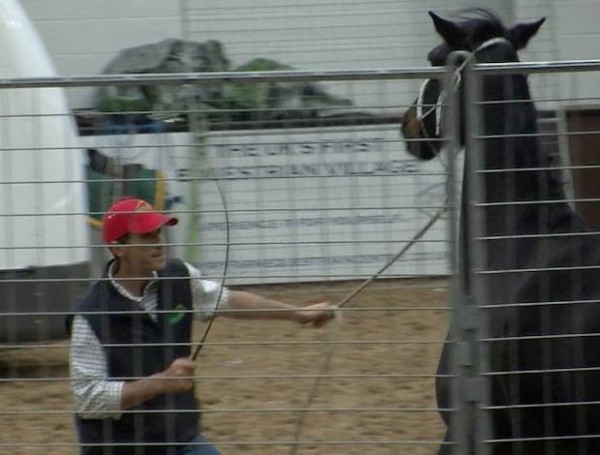
The use of negative reinforcement and positive punishment is commonplace in natural horsemanship. (Image used with permission from Epona.tv)
“He follows me out of trust and respect”
Without understanding the reinforcers fully, certain results can seem “magical” and warrant elaborate explanations, hence where the terms horse whispering has come from. Round pen training gets very quick, impressive looking results, therefore it is easy to believe that the horse follows the trainer out of trust and understanding. The miraculous transformation of an initially scared horse following the trainer around within minutes is explained by the fact the trainer has tapped into part of the horse’s language and is acting as the “alpha horse”.
However, it can too be explained by the effective administration of negative reinforcement. When the horse turns away from the trainer he is sent away, chased around in a pen he cannot escape from. The horse finds this very frightening and stressful and will try to avoid. When the trainer sees signs that the horse is beginning to focus on him he will stop the advances, increasing the frequency of approach behavior. The horse quickly realizes that the only way he can avoid the feelings of fear created by being chased around the pen is to stick nearby the trainer. Rather than following out of trust and partnership the horse follows because he is too scared not to.
Interestingly the same results have also been replicated by using a remote control car. In 2012, a team of researchers lead by Cath Henshall, a Master of Animal Science at the University of Sydney, were able to train horses to follow and touch the inanimate object using similar methods. This disproves claims that the horse follows the trainer due to them being able to tap into the horses language. Henshall warns against the widespread use of this technique as “it uses fear to gain control of horses.”
The amount in which this behavior occurs naturally is disputed. A study has found that when two un-introduced horses are placed in a round pen together they spend the vast majority of the time apart. The older horse does not chase the younger horse around in an attempt to get him to remain close. These methods have also been proven to be context specific, horses may perform the desired behavior in the arena but not in the field.
Be The Dominant Leader
Another common misconception that has lead to so much confusion about how we handle and train horses is the dominance theory. It has long been believed that horses have a dominance hierarchy, much like primates, where if anyone crosses the dominant horse they would be reprimanded. In actual fact, this dominance theory in wild or feral equines does not exist, it is instead a man made concept.
By observing domestic horses at feeding time it is easy to assume that there is a hierarchy based on aggression. However, in natural conditions resources are equally distributed which means there is no need to defend or argue over food. There is either enough grass for everyone or not much anywhere, compared to bucket feeds or haynets which can be defended easily and cause an increase in stress around feeding time.
For this reason, rather than being a display of dominance, this aggression is instead known as ‘resource holding potential’ and occurs in relation to each resource—some may value hay more than others, and some may be ‘dominant’ in relation to shade. It has also been proven that despite their ‘rank’ within domestic herds the horses are equally trainable, which challenges the assumption that ‘lead’ horses are more challenging than others.
Rather than following the “dominant” bully in the herd, horses have been shown to follow the horses who perhaps have the best knowledge of where to find resources. She just goes and they follow, she does not herd, chase, kick or bite them if they don’t, they just follow because they want to. It has also been argued that instead of following a single “alpha mare” the herd will follow many individuals depending on the circumstances.
Over a 5 year period a herd of Zebra were observed, arguably the last truly wild equids. In all of this time no encounters of aggression were observed during the study. Surely this would not have been the case is aggression was essential for the herd to function?
That is because it isn’t. Being highly social herd animals survival depends on herd cohesion. Unsurprisingly then it has been found that activities that promote group living have evolved to be more prominent than those that threaten it. This means that there is little conflict between individuals and affectionate ‘bond building’ behaviors are significantly more frequently observed in naturally living horses than are aggressive encounters.
If horses in a wild herd work to avoid confrontation as much as possible and have a system based on “followership” rather than “leadership” then why is so much emphasis put on the trainer to be the “dominant leader?” Horses do not get herded by the most aggressive herd member, or bow down to their superiority and follow their every command, in fact they will actively avoid these individuals. Therefore, the core teaching and underlying principle of natural horsemanship is highly flawed.
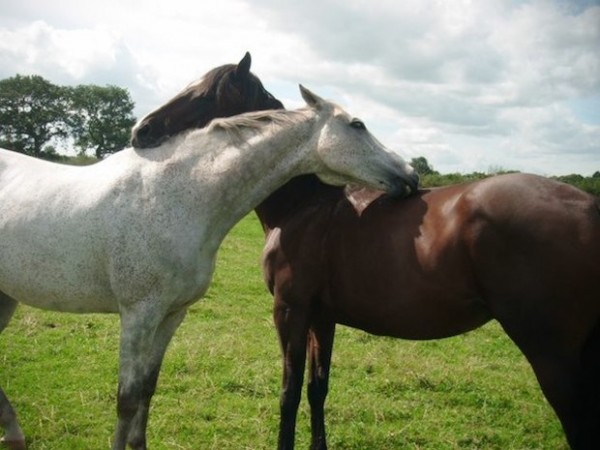
Affectionate behaviors are more common in well balanced herds than aggressive encounters are.
Fast Track Results
One of the major selling points of these “miracle” systems is their quick fix approach have all your problems solved in a 2 hour session! However, there are very real concerns about any method that claims to change behavior that rapidly. Repeated exposure to a scary stimuli from which the horse cannot escape is known as flooding. This is a common method used in order to get a horse to stop appearing scared of a stimuli, often called “desensitizing”. In natural horsemanship this can be seen when the trainer holds a stick or plastic bag next to them until they stop trying to escape, or forces them to remain in proximity to a scary object such as a jump.
A common lesson where flooding is exploited is backing. The horseman will put the saddle/rider/ plastic bags/etc. onto a naïve or fearful horse and sends him around an enclosed area until he stops trying to escape. The horse learns that no amount of bucking, running or other attempts at avoidance will make the scary things go away, and so he eventually stops trying. Flooding has been deemed unethical due to the high levels of stress it creates and compared to other methods the likelihood of the fearful response returning is significantly increased.
Continual flooding results in a state called conditioned suppression, where the subject appears shut down and calm. Rather than not being scared of the object anymore they just stop responding and suppress the behavior as an attempt to cope with the overwhelming situation of which they have no control. Conditioned suppression is in fact the objective of natural horsemanship, it’s what the training aims to achieve, and achieves very quickly due to the clever application of positive punishment and negative reinforcement. It’s the part where the horseman exclaims “Look, does that look like a stressed horse to you!?”, and everyone laughs, unaware that the horse licking and chewing in the corner is in a state of highly compromised welfare.
If flooding persists the horse will go into a state of learnt helplessness, a permanent shut down state where the horse has learnt that any response is futile. Seligman found that dogs who had learned they could not escape electric shocks simply lay down and whimpered when given the opportunity to escape them in the future. The dogs learned to be helpless and passively accept whatever punishment the experimenter subjected them to. This response has been likened to depression in humans.
Is this the attitude to training that we want to create in our horses? Because this is what is happening.

A young horse being flooded at a colt starting event. Image used with permission from Epona.tv
Left brain, right brain
With this unrelenting stressor the horse will be experiencing chronic stress as the stress response is continually activated. This results in raised levels of the stress hormone Cortisol, which has very damaging effects on the physiology. It results in the digestive system shutting down, raised heart rate, raised blood pressure and suppressing of the immune system, making the horse more susceptible to disease, illness and infection. The horse will be in a constant state of fight or flight in an attempt to survive the situation which they perceive to be life threatening. This makes him very reactive, unpredictable and potentially dangerous. With such a compromised neurological state the brain is barely able to learn anything new, and memories slow to form, so many repetitions of training must be done before it sticks.
By using these techniques the horse’s behavioral response has been suppressed but the same mental processes remain. As this is the case the old behavior will often reappear, known as spontaneous recovery, as soon as stress levels are exasperated or the stimuli presented in a new setting. This gives way to the ‘left brain, right brain’ myth to explain complicated cognition, which has been completely disproved by scientists. Moreover, learning occurs physically in the brain. It is a muscle, and it needs time to change and adapt to new situations. Trying to undo years of learning and go against millions of years of evolution by forcing the horse into a terrifying situation that it cannot escape does not produce good learning. The brain simply cannot develop and change this quickly. By adhering to this quick fix hysteria and egotistical approach the horse’s physical and psychological well-being is highly compromised, and results will be superficial.
Find an ethical alternative
With all things considered it becomes clear that natural horsemanship is not in the horse’s best interest. It may look impressive and feed the trainers ego but at a huge expense to the equine participant. The foundations from which it teaches are disputed by ethologists, the pretense of the ‘alpha horse’, leadership and dominance are being gradually dispelled. From this misunderstanding comes training methods based on fear, suppression and force with the ultimate goal being that of emotional shut down of the animal. The high levels of stress which these training methods create poses physiological problems, making it more difficult to learn new behaviors and suppressing the immune system. And perhaps, the most disturbing fact of all is that more often than not, the person doing the damage is the person who loves and wants the best for their horse. They are told that this will improve their relationship with the horse when in fact the reality is completely the opposite; lack of trust, conditioned suppression, negative associations to training and increased fear of the trainer.
Surely when owners and trainers alike are able to recognize these mechanisms they are in a better position to make informed decisions regarding their horse’s welfare. For myself these methods are unacceptable as I strive for better understanding, better communication and a better relationship with the equines I work with. Rather than the procedures already described I propose that it is better practice to aim to reduce emotional stress in training where possible.
When dealing with horses which display avoidance behaviors it is important to first consider the function of the behavior rather than label it with simplistic, anthropomorphic terms such as “he’s being disrespectful”. It is more likely that he is fearful or does not understand what is required of him. From identifying the causality and function of the behavior the trainer can then create a tailored behavior modification program to change the emotional response.
Methods such as habituation, where the horse is gradually exposed to a new stimuli without fear, or counter conditioning where the old response is replaced with a new response, are considered not only more ethical but more effective in modifying undesirable behavior. The increased use of positive reinforcement within these programs also changes the horse’s attitude to training, increasing motivation and enthusiasm and creating rapid learning. When all of these steps have been taken successfully, that is when you will see a horse who truly wants to work with you. Moreover you will improve your relationship with your horse and gain a mutual understanding. Only then will your horse be truly happy and relaxed in his work.
This article only scratches the surface of some of the questionable practices that occur in natural horsemanship systems. I hope that by enlightening you to some of them you are now able to view the systems with open eyes. It hardly comes as a surprise that in order to achieve a happy, relaxed and enthusiastic horse you don’t need to hit, punish, suppress or terrify him. With proper application and consideration of modern research the desired result of true partnership can be achieved without such a high cost to the emotional well-being of horse and trainer alike.
Edited by Laura Gibbons
This article was written by a licensed equine behaviorist and does not necessarily represent the views of Horse Network. All articles are for informational purposes only.

 September 16, 2015
September 16, 2015 














